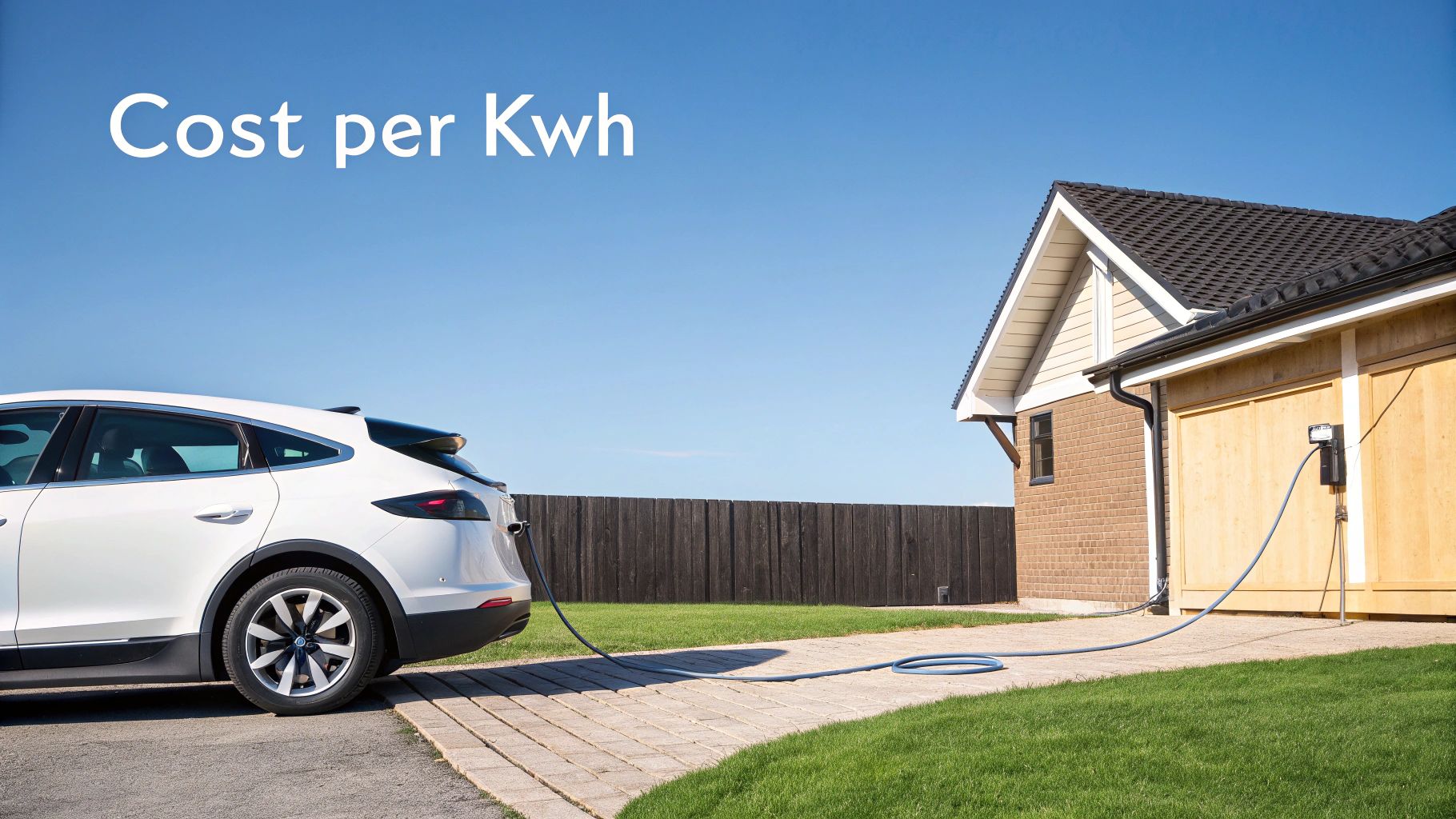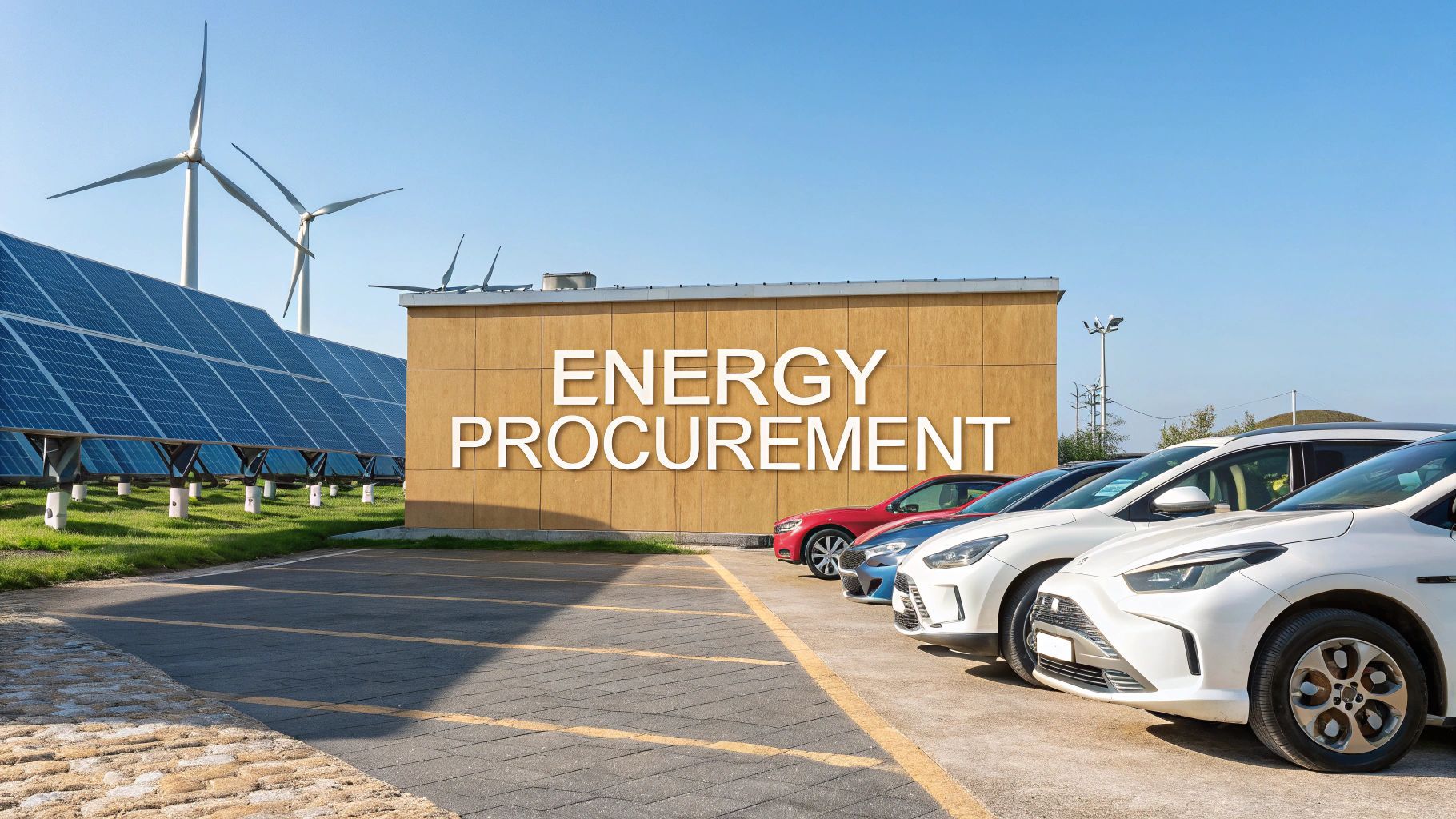What Does kWh Mean Explained Simply
A kilowatt-hour, or kWh , is the fundamental unit we use to measure energy. Think of it like a litre of petrol for your car – it is a standard amount.
Grasping what a kWh represents is the key to understanding everything from your home electricity bill to how you charge an electric vehicle (EV). In simple terms, power (kW) is how fast you use energy and energy (kWh) is the total amount you have used over a period of time.
What a Kilowatt-Hour Really Means
Let us cut through the jargon with a simple analogy. Picture a running tap. The speed at which water flows out is like power, measured in kilowatts (kW). The total amount of water you collect in a bucket over an hour is the energy consumed. That bucketful of water represents one kilowatt-hour (kWh).
This concept is vital in the world of EV charging, distributed energy and modern energy systems. When you look at an electric car’s specifications, its battery size is listed in kWh, which tells you how much energy it can store. The same goes for large grid-scale batteries, which are essential for storing renewable energy – their capacity is measured in kWh or, for the really big ones, megawatt-hours (MWh).
A kilowatt-hour is the standard unit of energy that electricity suppliers use to bill you. One kWh is simply the amount of energy used by a one-kilowatt appliance running for one full hour.
This measurement applies to everything from a tiny phone charger to the most powerful rapid EV charging stations. For context, the average UK household consumed about 3,449 kWh of electricity annually in recent years. Interestingly, that number has been dropping, thanks to more efficient technology and people becoming more energy-conscious. You can explore more about these trends on heatable.co.uk.
Getting a handle on the kWh is the first step towards taking control of your energy costs, especially when you are dealing with things like mobile EV charging or systems combining on-site renewables with battery storage.
Decoding Your Electricity Bill
That monthly bill landing on your doormat or in your inbox is not just a random number; it is a story about your energy usage, told in the language of kilowatt-hours, or kWh . Getting your head around this is the first step to truly managing your energy, whether you are dealing with on-site renewables, EV charging and batteries, or even mobile EV charging solutions.
To see what this means in practice, just grab your latest bill. You will find your total consumption listed in kWh and the specific price per unit—usually in pence per kWh—that your supplier charges. This simple figure is the bedrock of your entire bill.
This infographic breaks down the relationship between the power your appliances draw, the time you use them, and the resulting energy for which you are billed.

It is a great visual for understanding how the power you use over time adds up to the final kWh total on your bill.
Connecting kWh to Your Costs
So, let us translate this into real-world pounds and pence.
Imagine your electric oven has a power rating of 2 kW and you pop it on for two hours to cook a Sunday roast. The calculation is surprisingly straightforward:
- 2 kW (Power) x 2 hours (Time) = 4 kWh (Energy Used)
If your electricity tariff is 25p per kWh , the cost for that roast is £1.00 . Simple. Once you apply this logic to all your appliances, you can start to see exactly where your money is going.
To give you a better idea of how different devices stack up, here is a quick look at some common household appliances and their potential daily running costs.
Daily Appliance Energy Use and Cost
This table shows the estimated kWh consumption of common household appliances and their running costs based on an average UK electricity tariff.
| Appliance | Power Rating (kW) | Hours of Use per Day | Daily kWh Consumption | Estimated Daily Cost |
|---|---|---|---|---|
| Electric Kettle | 3.0 | 0.25 | 0.75 | £0.19 |
| Washing Machine | 2.1 | 1 | 2.1 | £0.53 |
| Tumble Dryer | 2.5 | 1.5 | 3.75 | £0.94 |
| Dishwasher | 1.8 | 1 | 1.8 | £0.45 |
| Fridge Freezer | 0.2 | 8 | 1.6 | £0.40 |
| LED TV | 0.08 | 4 | 0.32 | £0.08 |
Note: Costs are estimated using an average tariff of 25p/kWh. Your actual costs will vary based on your specific tariff and usage patterns.
Seeing the numbers laid out like this really highlights which appliances are the most power-hungry. A tumble dryer, for instance, can cost nearly a pound for a single cycle.
This knowledge becomes even more powerful when you are dealing with more complex scenarios, like rapid EV charging from a constrained grid connection or optimising a grid-scale battery storage system. By understanding your consumption patterns, you can start making much smarter decisions. After all, effective home energy management starts with this basic insight into your usage.
By connecting the abstract kWh unit to the concrete cost on your bill, you gain the power to identify which appliances are driving up your expenses and find practical ways to reduce spending.
Why kWh is King for EV Drivers
If you are an electric vehicle driver, the kilowatt-hour is your new litre of petrol. Think of it this way: an EV's battery capacity is measured in kWh , a number that tells you exactly how much energy it can hold and, ultimately, how far you can travel on a single charge. Getting your head around what kWh means is the first step to mastering your EV.
This move from fuel tanks to batteries completely changes the game. Instead of paying per litre at the pump, you now pay per kWh at the charger. The calculation is straightforward but powerful: just multiply the kilowatt-hours your battery needs by the price per kWh from your energy supplier or charging network. This makes it incredibly easy to compare costs between different charging options, from rapid EV charging hubs to mobile EV charging units.

Efficiency and Charging Costs
The real secret weapon for savvy EV drivers is efficiency, which we often talk about as ‘miles per kWh’. This is the electric equivalent of ‘miles per gallon’ and it shows you how well your car is using its stored energy. Several things can affect this figure:
- Your Driving Style: Heavy acceleration and sharp braking drain energy much faster, lowering your miles per kWh. A smoother ride is a more efficient one.
- The Weather: Cold temperatures can slash your battery’s efficiency and range by as much as 20-30% . That is because energy gets diverted to keep the cabin—and the battery itself—warm.
- Terrain and Speed: It takes a lot more energy to climb a steep hill or maintain high speeds on the motorway than it does to cruise around town.
Understanding your car’s efficiency helps you accurately predict your range and keep costs down. For example, charging a 75 kWh battery at home on an off-peak rate of 15p per kWh would cost just £11.25 . But if you use a public rapid charger priced at 75p per kWh , that same charge will set you back £56.25 .
Mastering the relationship between kWh, charging prices, and vehicle efficiency is the key to unlocking the full economic benefit of driving an electric vehicle and making informed decisions about where and when to charge.
This knowledge becomes even more vital when you are managing entire EV fleets or installing rapid EV charging where the grid is already under strain. Distributing power effectively without overloading constrained grid connections is a serious challenge. To see how technology is solving this, check out our in-depth guide to dynamic power management for EV charging. By intelligently balancing charging speeds and energy flow, these systems ensure vehicles get the juice they need without compromising grid stability, making large-scale EV adoption a reality.
The Bigger Picture for kWh in the UK
Beyond your home and car, the kilowatt-hour is the fundamental unit of currency for the UK's entire energy network. While we might think in terms of single kWh units for our household bills, the national grid operates on a much grander scale, dealing in megawatt-hours (MWh) and even gigawatt-hours (GWh) . Understanding these larger volumes is key to grasping the immense challenge of balancing energy supply and demand across the country.
This is where grid-scale batteries come into play. These are enormous energy storage facilities, designed to soak up excess electricity from combined on-site renewables like wind and solar. When the wind is blowing strongly at night but demand is low, these batteries can store millions of kWh, holding that energy until it is needed most.
The Rise of Distributed Energy
At the same time, the energy landscape is being reshaped from the ground up by distributed energy . This simply means energy is generated and stored much closer to where it is actually used. A business with on-site renewables like solar panels and an integrated battery system, for example, is now an active participant in the grid.
They generate their own kWh during sunny spells, stash the surplus in their battery for later, and can even sell it back to the grid. This shift turns passive consumers into active "prosumers," helping to build a more flexible and resilient energy system for everyone.
The kilowatt-hour is no longer just a measure of consumption; it has become a tradable commodity for households and a critical balancing tool for the entire UK grid, enabling a future powered by renewables.
Overcoming Modern Energy Hurdles
Of course, this new energy model comes with its own technical hurdles. Take mobile EV charging , a vital service for roadside assistance or powering fleets in remote locations. These solutions require precise kWh management to deliver a meaningful charge without wasting energy.
Similarly, deploying rapid EV charging hubs is often tricky in areas with constrained grid connections . Innovators are tackling this by pairing on-site renewables with battery storage to create self-sufficient charging ecosystems. These systems store up energy during off-peak times and use it to power chargers directly, neatly bypassing grid limitations. This combination of EV charging and batteries is crucial.
Every single kWh must be managed carefully to ensure the system is stable, reliable, and ready for a future dominated by electric transport. To see how this technology works on a larger scale, you can learn more about how grid-scale battery storage is powering the UK and building a more robust national infrastructure.
The True Environmental Cost of a kWh
Here is a simple truth: not all kilowatt-hours are created equal. While a kWh is just a standard unit of energy, its real-world environmental impact swings wildly depending on how and when it was made. This is all down to its carbon intensity —a measure of how many grams of carbon dioxide (CO₂) were released to produce that single kWh.
Understanding this is crucial because the UK's energy mix is constantly changing. On a bright, windy day, the grid is swimming in clean power from wind turbines and solar farms. A kWh used then carries a tiny carbon footprint. But fast forward to a still, grey evening when everyone gets home and switches things on. Gas-fired power stations fire up to meet the demand and suddenly, each kWh becomes much, much dirtier.

Carbon Intensity in the UK
Looking at the carbon intensity of the UK grid gives us the full picture. For instance, back in January 2024, the figure stood at 168 gCO₂/kWh . That is a relatively high number for recent years, driven mostly by a heavy reliance on gas, which made up 38% of our electricity.
This constant fluctuation has huge implications for anyone managing energy, whether you are running a fleet of EVs, a business with combined on-site renewables, or even grid-scale batteries.
Understanding the carbon intensity of a kWh allows us to make smarter energy choices. It is not just about how much energy you use but critically, when you use it.
By shifting power-hungry jobs to times when the grid is greener, we can make a genuine difference. It is all about timing.
- Smart EV Charging: This could mean setting your electric car to charge late at night. Why? Because wind power is often plentiful then, dropping the grid's carbon intensity right down.
- Battery Storage Optimisation: It also applies to grid-scale batteries. You can programme them to charge up when energy is cheap and clean, then release that stored power during those dirty, expensive peak times.
When we talk about the environmental cost of a kWh, it is also worth remembering the impact of energy efficiency on CO2 emissions , which applies even to the smallest devices. After all, every single kWh you save is one that never needed to be generated in the first place, lightening the load on the grid and helping push the UK’s decarbonisation goals forward.
A Few Common Questions About kWh
Even when you have got a handle on what a kilowatt-hour is, a few questions nearly always pop up. Let us clear up some of the most common ones, especially those that come up around EV charging, grid-scale batteries and the UK’s distributed energy system.
What Is the Real Difference Between kW and kWh?
The simplest way to break it down is that a kilowatt (kW) measures power and a kilowatt-hour (kWh) measures energy . Think of it like speed and distance. Power (kW) is the rate you are using energy at any given moment—like how fast you are driving. Energy (kWh) is the total amount you have used over time—like the total distance you have travelled.
For instance, a rapid EV charger might deliver power at a rate of 50 kW . If you plug your car in for one full hour at that constant rate, you will have added 50 kWh of energy to its battery.
Think of kW as speed and kWh as distance. One tells you how fast you are using energy right now and the other tells you how much you have actually used. Getting this right is vital for everything from mobile EV charging to managing huge grid-scale batteries.
How Many kWh Does It Take to Charge an EV?
That all comes down to the size of your car’s battery, which is its total capacity for storing energy. A smaller electric vehicle might have a 40 kWh battery but a larger, long-range model could easily have a 75 kWh battery or even more.
So, to charge from completely empty to full, you would need to put that much energy back in. In the real world, you will actually need a little more—usually around 5-10% extra —to make up for small energy losses that happen during the charging process itself.
Why Does the Price per kWh Change?
In the UK, the cost of a single kWh is not fixed. It moves up and down for a few key reasons and that directly affects what you pay for rapid EV charging or powering your home with distributed energy.
- Your Energy Tariff: This is the biggest one. Your electricity plan dictates your price. Many modern tariffs offer much cheaper off-peak rates, typically overnight, to encourage people to use energy when there is less demand on the grid.
- Wholesale Market Prices: Your supplier buys electricity on the wholesale market, where the price is always shifting with supply and demand. The amount of renewable energy being generated and the global price of gas have a huge impact on these costs.
- Network and Levies: Part of your bill goes towards maintaining the national grid. It also includes government taxes and environmental levies, all of which can be adjusted over time.
This constant fluctuation is exactly why smart energy management—using things like on-site renewables and battery storage—is becoming so essential for keeping costs under control, especially when deploying EV charging from constrained grid connections.
At ZPN Energy , we provide the advanced charging and energy storage solutions needed to navigate the modern energy landscape. Discover our integrated systems.








